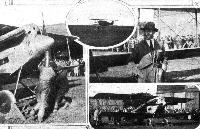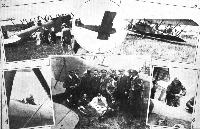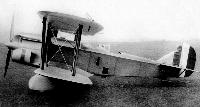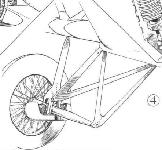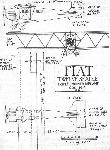Fiat BR, BR.1, BR.2, BR.3 и BR.4
В 1918 году Челестино Розателли приступил к работе в конструкторском бюро "Societa Italiana Aviazione" (SIA), авиационном отделении компании "Fiat". Первой работой конструктора стал биплан-разведчик SIA 9, на который возлагались большие надежды. Правда, самолет получился совсем неудачным. Вторым проектом стал легкий биплан-бомбардировщик Fiat BR (Bombardiere Rosatelli), сконструированный в 1919 году. К этому времени марка SIA сменилась на "Fiat". В апреле 1919 года на новом BR было установлено сразу несколько мировых рекордов - двухместный самолет поднял трех (!) пассажиров на высоту 7240 м, а с одним пассажиром развил максимальную скорость 270 км/ч.
Испытания BR завершились в Монтечелло в 1922 году, после чего самолет запустили в серию и стали поставлять военным. 23 марта 1923 года фашистский режим реформировал Aeronautica Militare в Regia Aeronautica (Военно-воздушные силы), и продолжать получать биплан стали уже они.
От SIA 9 биплан BR отличался лучшей аэродинамикой и более прочной конструкцией планера, сохранив только общую конфигурацию двухстоечного биплана. Заново было спроектировано крыло, а оперение приобрело формы, ставшие отличительной чертой всех конструкций Розателли в последующее десятилетие. Открытая кабина летчика расположена непосредственно под вырезом в центроплане верхнего крыла, а сразу за кабиной летчика находится кабина стрелка-наблюдателя. На самолете установлен V-образный мотор A.14 мощностью 700 л. с.
Два BR продали Швеции, где они получили обозначение В 1.
Варианты
BR.1: в 1923 году Розателли предпринял попытку улучшить BR, спроектировав BR.1, который поступил в Военно-воздушные силы на следующий год; отличием стали, главным образом, W-образные стойки бипланной коробки, ставшие типовыми для всех последующих бипланов знаменитого конструктора; на BR.1 использовалось новое шасси с независимыми основными опорами с увеличенной шириной колеи; мотор A.14 сохранили, но лобовой радиатор заменили более современным; летные данные нового бомбардировщика возросли, так же как и масса бомбовой нагрузки; на BR.1 установили новый мировой рекорд - подъем груза массой 1500 кг на высоту 5516 м; на BR.1 испытывался новый револьверный бомбодержатель, проводились эксперименты по сбросу торпед; построили около 150 BR.1, почти все они поступили в ВВС Италии; Швеция закупила два самолета, получившие местное обозначение В 2
BR.2: первый полет прототип BR.2 выполнил в 1925 году; на самолете стоял новый мотор Fiat A.25, была усилена конструкция, увеличен запас топлива, изменено шасси; в 1930 году примерно 15 легких бомбардировочных эскадрилий ВВС Италии имели на вооружении самолеты данного типа, но BR.2 быстро устарел
BR.3: улучшенный и увеличенный в размерах BR.2 появился в 1930 году; построили порядка 100 самолетов для ВВС Италии, одну машину купила Венгрия. На самолете установили модернизированный мотор A.25, в очередной раз доработали шасси, впервые на самолете смонтировали приемо-передающую радиостанцию и панорамный аэрофотоаппарат; самолеты поздней постройки выпускались с предкрылками (типа Хэндли Пейдж); в середине 1930-х годов BR.3 передали в учебные части, несколько самолетов летали еще в 1940 году
BR.4: этот последний бомбардировщик-биплан конструкции Розателли выполнил первый полет в 1934 году; конструкция подверглась коренной переделке, установлен лобовой подфюзеляжный туннельный радиатор, как на CR.30 и CR.32, двигатель A.25 сохранен, изменена конструкция шасси, на колеса установлены обтекатели; BR.4 по скорости уступал новейшим бомбардировщикам-монопланам, построен единственный прототип
ТАКТИКО-ТЕХНИЧЕСКИЕ ХАРАКТЕРИСТИКИ
Fiat BR.2
Тип: двухместный бомбардировщик
Силовая установка: один V-образный мотор Fiat A.25 мощностью 1090 л. с. (813 кВт)
Летные характеристики: максимальная скорость на оптимальной высоте 240 км/ч; время набора высоты 4000 м -15 мин 46 с; практический потолок 6250 м; дальность полета 1000 км
Масса: пустого 2646 кг; максимальная взлетная 4195 кг
Размеры: размах крыла 10,66 м; длина 10,66 м; высота 3,91 м; площадь крыльев 70,22 м2
Вооружение: один неподвижный 7,7-мм пулемет Vickers в носовой части фюзеляжа и один 7,7-мм пулемет Lewis на турели в кабине стрелка, до 720 кг бомб в фюзеляжном бомбоотсеке
Показать полностьюShow all
Flight, January 1920
The Paris Aero Show 1919
The Fiat Machine
In the two-seater class the Fiat was one of the finest machines exhibited at the show. Fitted with a Fiat engine of 700 h.p., the machine is stated to be able to maintain a speed of 162 1/2 m.p.h. for 20 hours. This should have enabled her to make the Transatlantic journey with ease, and this, as a matter of fact, was the purpose for which the machine was originally designed. When the flight was accomplished by the late Sir John Alcock and Sir Arthur Whitten Brown, the Fiat was not put to the actual test, but there is little doubt that the machine will be heard of in connection with some really fine flights during the year just commenced. Thus it is rumoured - on dit - that after the closing of the Paris Aero Show it is intended to attempt a non-stop flight from Paris to Cairo, a flight which, if it succeeds, will reflect great credit on the designers of both the machine and its engine.
The accompanying illustrations will give some idea of the general outline of the beautiful Fiat biplane, type A.R.F. The body is of generous proportions, partly on account of the large 700 h.p. Fiat motor, and partly to afford space for the large tanks necessary to hold sufficient fuel for 14,000 h.p. hours. As a matter of fact, one need not take the statement of 20 hours at 162 1/2 m.p.h. too literally. The duration has probably been worked out for cruising speed while the speed stated is probably the maximum. Even so, however, the performance is no mean one. With the large heavy engine out in front and the tanks approximately over the centre of pressure, the seats for the two occupants are fairly far back, behind the trailing edge of the planes, where the view, in spite of the bulky fuselage, is quite good.
The main planes show the usual Fiat bracing, i.e., there is in the centre a set of struts placed in W formation, the main inter-plane struts are raked outwards, and the bay nearest the body has no cable bracing, a diagonal strut for each spar performing the double function of lift and anti-lift member.
Ailerons are fitted to the top plane only, and are balanced by small auxiliary planes mounted on brackets from the main aileron and placed above the main plane. Similar forms of aileron balances have been employed by Avros in this country and by various German designers.
In other respects the Fiat is of more or less standard design, and the merits of the machine do not so much lie in any particular ingenious detail as in an all-round efficiency and cleanness of design.
The span of the Fiat biplane is 53 ft. 2 ins., the length 33 ft. 3 ins., and the height 12 ft. 2 ins. The weight of the machine empty is 5,150 lbs. The weight of petrol and oil for the 3,000 miles journey is 4,672 lbs., and the remaining useful load, which includes the pilot and passenger, 450 lbs., giving a total loaded weight of 10,272 lbs.
Показать полностьюShow all
Flight, November 1920
THE F.I.A.T. TWELVE-SEATER BIPLANE
UP to now large machines carrying passengers to the number of ten or more have generally been of one type, in which multiple-engines are mounted on the wings, either in separate nacelles, or in auxiliary fuselages as in the Caproni. The single tractor-screw fuselage type of machine is practically unknown in the "larger sizes." No doubt the principal reason against the use of this type for large machines is the question of obtaining single engines of sufficiently high power, or the difficulty of gearing satisfactorily more than one engine to a single screw.
The well-known House of Fiat, however, have recently designed a large tractor biplane, which, apart from the question of type, possesses several interesting features, and we give herewith a description, together with scale drawings, of this machine.
The principal feature of this machine consists of the arrangement of the power plant. This is the patent Fiat triple-engine unit, which is mounted in the nose of the fuselage as in an ordinary single-engine tractor machine. It consists of three vertical engines grouped side by side, each driving a single tractor screw through a gear-box. Should any one of the three engines develop trouble, it is automatically cut out from engagement. Means is also provided whereby any of the engines may be disengaged by the pilot or mechanic, as required, thus enabling certain repairs or adjustments being made whilst in the air. As the maximum combined horse-power developed by the three engines (900 h.p.) is well above that required for normal flight, the cutting-out of one engine - whether by accident or design - results only in a decreased r.p.m. of the tractor screw, with a corresponding decrease in the speed of the aeroplane, which is, however, quite sufficient for safe flying. It is claimed for this arrangement that it possesses the advantages of the single-engined tractor type, combined with those of the multiple-engined systems. The maximum horse-power of 900 (1,850 r.p.m.) is only occasionally used, the normal power developed being 700 h.p. (1,600 r.p.m.), when the speed of the machine is in the neighbourhood of 115 m.p.h. - the maximum speed is 125 m.p.h., whilst it is claimed that the landing speed is as low as 50 m.p.h.
The arrangement of the fuselage also has several points of interest. The fuselage is exceptionally deep overall, being only a little less in depth than the gap of the planes, the measurements being 8 ft. 3 ins., and 8 ft. 6 ins. respectively. The main structure of the fuselage, carrying the principal weights - power-plant, tanks, cabin, etc. - forms the lower half, the upper half being, to all intents and purposes, a cowling or turtle deck. The main structure is a combination of girder and 3-ply construction, rectangular in cross-section and tapering to a vertical knife-edge at the rear. The middle portion of the fuselage constitutes the passengers' cabin and lavatory. The main cabin is 10 ft. 6 ins. in length, and has an average height and width of 6 ft. and 5 ft. respectively. There are two rows of five comfortably-upholstered seats, with a central gangway between them, from which two flights of steps - one coming from the pilot's cockpit in front - lead to a trap-door in the bottom of the fuselage, the floor of the cabin being about two feet above the latter.
In the sides of the cabin above the top longitudinal of the main fuselage structure are sliding windows, extending from end to end, and providing a fairly good view below. At the rear of the cabin is a small compartment fitted as a lavatory. The pilot's and mechanic's cockpit is located immediately in front of the cabin, high up in the fuselage, beneath the front main spar of the top plane. In this position the pilot has an excellent view forward and downward, although somewhat restricted in an upward direction. If necessary, the mechanic can take control of the machine by means of a dual-control system. The pilot's cockpit is separated from the engine compartment immediately in front by a partition in which is a sliding door giving access to the engines. A certain amount of warm air, from the radiator, is allowed to enter the pilot's cockpit.
The fuel tanks, which have a total capacity sufficient for a flight of 6 hours or 600-750 miles, are located below the floor of the cockpit and stairway leading from the latter to the cabin.
The main planes have neither sweep-back nor stagger, but the lower plane, which is of shorter span than the upper one, is set at a dihedral angle of about 2 degs. Except for the incidence wires there is no external wire bracing, owing to the employment of the Warren type of interplane-strut bracing.
Ailerons are fitted to the top plane only, and these are balanced by means of a small horizontal surface mounted in front of and above the aileron. The rudder and elevators are balanced in the usual way, by means of forward projecting surfaces.
The angle of incidence of the tail plane can be adjusted from the pilot's cockpit whilst the machine is in flight.
A strong four-wheeled undercarriage is fitted, one pair of wheels, carried by a V-type chassis, being situated below the planes, and the other pair, also carried by a V-chassis, being mounted forward. A factor of safety of over eight is employed throughout the construction of this machine.
Показать полностьюShow all
Flight, May 1924
THE FIAT "C.R.," "R.S." AND "B.R." BIPLANES
WE give below some brief particulars of three recent Italian biplanes constructed by the Fiat Co., of Turin. All three are military machines possessing more or less distinctive features.
<...>
The Fiat "R.S." is a similar, but larger edition of the "C.R." and is intended for offensive and defensive reconnaissance work. It is a two-seater, and is provided with two machine guns, one mounted forward firing through the airscrew and operated by the pilot, the other being mounted on a gun ring in the rear observer's cockpit. In other respects this machine follows the general design and construction of the "C.R.," and is fitted with the same engine - a 300 h.p. Hispano-Suiza. The principal characteristics of the "R.S." are as follows :-
Span (top) 30 ft. 0 ins.
Span (bottom) 36 ft. 9 ins.
O.A.length. 24 ft. 6 ins.
Height 9 ft. 4 ins.
Chord 6 ft. 0 ins.
Wing area 387 sq. ft.
Weight (empty) 2,200 lbs.
Weight, fully loaded 3,500 lbs.
Useful load* 1,300 lbs.
Weight per square foot 9-6 lbs.
Weight per h.p. 11 lbs.
Safety factor 10
Speed (ground level) 148-8 m.p.h.
Speed at 6,500 ft 142-6 m.p.h.
Climb to 13,000 ft 21 mins.
Ceiling 18,700 ft.
Endurance 3 hrs.30 mins
* Useful load :- Petrol, 518 lbs. observer, instruments, etc., 352 lbs; oil, 77 lbs.; pilot; armament, 185 lbs.; aerial camera, W/T, etc., 190 lbs.
The "B.R." is a two-seater day bomber, of which there are two models, the standard type as adopted by the Italian army, and a slightly larger model employed for long range work; these differ only as regards dimensions, etc. The principal features of the "B.R." are its high speed, good climb, and weight-carrying qualities
Both models are fitted with the 700 h.p. Fiat A-14 engine, with a honeycomb radiator mounted in the nose of the fuselage. In the "B.R." the arrangement of the main plane is of the more orthodox type, i.e., straight-top plane and lightly smaller span lower plane set at a dihedral angle. The Warren type bracing is, however, again employed. Ailerons are fitted to the top planes, and are balanced by small auxiliary surfaces mounted above and in front of the leading edge of each aileron.
The fuselage is of girder construction, with spruce longerons cross-braced with wire. The pilot's cockpit is located at the trailing edge of the main planes, and the observer's cockpit is immediately behind. Dual control is fitted. The main petrol tank is located in the fuselage at the centre of gravity a smaller supply tank being mounted on the top plane.
The characteristics of the standard model follows :-
Span (top) 50 ft. 9 ins.
Span (bottom) 47 ft. 3 ins.
O.A. length 33 ft. 4 ins.
Height 12 ft. 6 ins.
Chord 7 ft. 9 ins.
Wing area 742-5 sq. ft.
Weight, empty 5,000 lbs.
Weight fully loaded 7,276-5 lbs
Useful load* 2,200 lbs.
Weight per sq. ft. 9-7 lbs.
Weight per h.p. 10-3 lbs.
Safety factor 9
Speed (ground level) 160-5 m.p.h
Speed (6,500 ft.) 152 m.p.h.
Climb to 13,000 ft. 21 mins.
Ceiling 19,680 ft.
Endurance 3 hrs.30 ms
*Useful load :- Petrol, 827 lbs.; oil, 176-4 lbs.; pilot and observer, 330-75 lbs.; armament and bombs, 871 lbs.
Показать полностьюShow all





